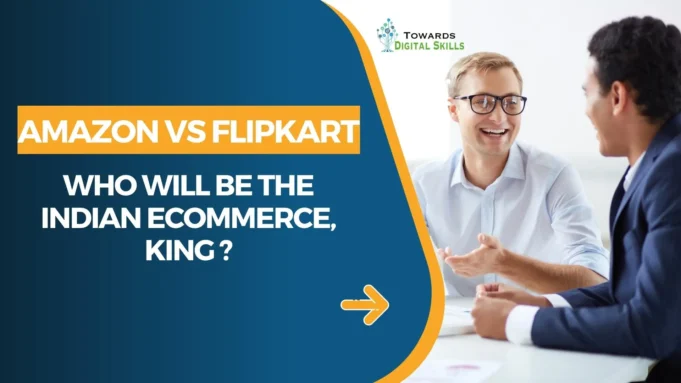With the competition heating up on both sides of the Atlantic, the question is: Amazon Vs Flipkart – who will emerge as the ecommerce king of India? We also look at how social commerce and other factors may play a role in customer satisfaction.
In 2023, The Indian Ecommerce Space:
The rise of the digital market has spurred the Indian ecommerce space. The growth is primarily driven by government initiatives, increased internet penetration, and the growing number of online shoppers in India. The D2C business model has helped the Indian e-commerce industry grow more quickly. IDC predicts that by 2023, the Indian e-commerce market will be worth $400 billion. Content commerce is the practice of promoting and selling products and services through the consumption of content, including short-form videos and social media.
GlobalData has estimated that by 2023, the e-commerce market in India will exceed US$ 91 billion. It is projected to grow from INR 3.44 trillion in 2017 to $6.7 trillion in 2023. The global e-commerce market is anticipated to expand at a rate of 13.9 percent yearly.Meanwhile, the point-of-sale market will grow by 13.4%. By 2023, digital wallets are expected to make up more than half of all ecommerce transactions and surpass cash as the number one POS payment method.
With increasing income levels in smaller towns, ecommerce players are reaching out to these areas. Increased penetration of high-speed internet services is one of the critical factors for the future of the Indian ecommerce space. In addition to this, freebies and technology have compelled smaller towns to take the plunge and embrace online shopping. As a result, ecommerce platforms are finding ways to hook these towns by offering targeted products and services.
The growth of ecommerce in India is projected to be exceptional in the coming years. Amazon and Flipkart are expected to be the leaders in this sector. In the e-commerce marketplace paradigm, the government has also promoted increased foreign direct investment. It is anticipated that the e-commerce sector will increase exports. earnings and jobs. In addition, it will boost government revenue and tax collection by exchequencies. This increase has a multitude of causes, including the COVID-19 pandemic.
Flipkart Takes On Amazon:
The duopoly of India’s ecommerce market is becoming a reality. Amazon and Flipkart command roughly 80 percent of the market. Amazon has substantial financial resources, but the duopoly is still strong. The companies are burning cash on customer acquisition, heavy discounts, and offers, which is not sustainable in the long run. Flipkart is relying on network effects and scale to emerge as the winner in the Indian ecommerce market.
Earlier, Flipkart was run by a small team with strong management. After its acquisition of Myntra, it brought in Silicon Valley executives and realigned its management structure. This has resulted in some confusion among its employees. However, the changes have paid off. This is a good thing, considering that India is a mobile-first country. Hopefully, this strategy will continue.
The bidding war is on as Amazon and Flipkart both want to gain a greater market share in India. However, the Amazon-Flipkart bid is likely a way for them to raise more money and make Flipkart even bigger. Moreover, the two companies are closely linked and would have a greater scale than if they didn’t compete. And if Flipkart doesn’t get the deal, they can always buy other startups in the same market.
Christmas season sales are crucial for any retail business, and the festive season is no exception. With a record number of shoppers and discounts, ecommerce sales during this period will skyrocket. Earlier, the market was stagnant, but this year, Flipkart took over from Amazon as the Indian eCommerce King. It has also partnered with Inc42, an analytics platform, to analyze customer experiences in real-time.
Flipkart Poached Most Visit From Social Commerce:
Almost a decade ago, Facebook was the leader in social commerce in India. Today, however, the social media phenomenon has been adopted by Flipkart. According to the company, tier-2 and tier-3 cities have become key targets for the company to expand its platform. But, it’s unclear what is driving this shift. Flipkart has also emphasized the importance of expanding its platform to tier-2 and tier-3 cities.
As social commerce has become increasingly popular in developing countries, the homegrown e-commerce market has made a significant investment in experimenting with it. Shopsy, a mobile app that enables Indians to launch their own online business without spending any money, was just released by the company. With Shopsy, users can influence their local networks, fulfil their dreams, and share catalogues from Flipkart sellers. There are over 15 crore products on Flipkart, which aims to reach every single one of these customers.
The company recorded 992 million similar views across the Google Play store, according to AppTweak, a site that estimates the number of similar app impressions. Meesho, meanwhile, brought in 307.7 million similar views. Amazon India, meanwhile, recorded 681 million similar views, but only 36% of these impressions came from its Flipkart page. Despite the hefty sums, these numbers still represent a significant loss for Flipkart, which is in a cutthroat race with Amazon.
Who Won The Customer Experience:
While both e-commerce platforms have a similar business model, the quality of their customer experience differs. For instance, Amazon has a higher level of customer satisfaction in terms of service, refunds, and replacement policies. In other areas, such as customer feedback and complaints, customers are more likely to use Amazon over Flipkart. While the two companies continue to dominate the online retail market, the Competition Commission of India (CCI) has accused them of stifling competition.
Both marketplaces are free to sell on. However, while Flipkart has a higher-quality customer experience, Amazon’s stringent registration policy makes it difficult for sellers to cheat. Customers will receive high-quality products as a result of this. Amazon is known for its fast approval of new seller accounts, but it’s easier to list products on Flipkart. Both marketplaces offer free listings, but Amazon has a slightly higher revenue per user.
Both websites have a customer review section, but Amazon’s has an easier-to-read format with several filters. The reviews are sorted chronologically and by date. Amazon also has a helpful graph. The graph helps you see the overall picture of the reviews. On the flip side, you must manually sort reviews by date to get an accurate picture. While Flipkart’s site features more Indian brands, Amazon offers a superior customer experience for Indian consumers.
While Flipkart has a simpler checkout process, Amazon offers better customer service. Its customer service representatives respond quickly and resolve any issues. Flipkart’s customer support representatives are notorious for not helping customers with their queries. The payment options on Flipkart are more limited than Amazon’s. Amazon accepts credit cards, debit cards, gift cards, cash on delivery, Wallet, Visa, and MasterCard.
























































